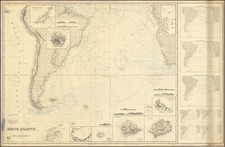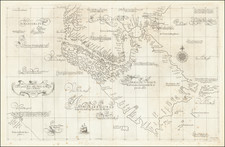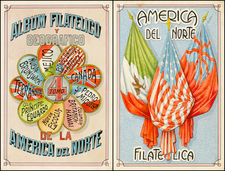Fine example of the single sheet version of Pedro Vicente Maldonado's map of the Province of Quito, one of the most important regional maps of South America published in the 18th Century.
The map is a reduced version of Maldonado's exceedingly rare 4 sheet map published in Paris, published posthumously under Condamine's supervision in 1750. This single sheet version was incorporated in La Condamine's authoritative account of the Spanish-French Geodesic Mission, Journaux de route et Mémoires de Mr. De la Condamine (Paris, 1751).
Focussed on what is today Ecaudor, the map extends from Jaen on the Rio Maranon in what is now northern Peru, all the way northwards to Popayan (Colombia), and runs from the Pacific coast over the Andes to include the upper reaches of the Amazon Basin. The map includes important cities such as Quito, Guayaquil, Cuenca, Popayan and Esmerladas. This vast region would have been one of the most challenging in the world to map, as it included thousands of square miles of coastal plains, volcanic peaks over 15,000 feet, and almost impenetrable jungles and malarial swamps.
Highly-detailed, the map depicts the innumerable rivers, mountains, towns, roads and mines that lay across this vast and magnificent land. The story behind its creation and publication is one of the most intriguing of any 18th Century work of cartography, and is revealing as to the larger interplay of science, commerce, politics and nationalism in Enlightenment Era Europe.
Maldonado, Condamine & the Story Behind the Map's Creation
Pedro Vicente Maldonado (1704-48) was an extraordinary figure of vast intellect and energies. Born into an influential Creole family in Riobamba, south of Quito, he was educated by the Jesuits. From 1722-24 he conducted a number of exploratory tours of regions of Ecuador seldom encountered by Europeans, creating his fist map in 1725. In 1724, he entered politics, and progressively rose from being the alcalde of Riobamba to being the Governor of Esmeraldas province. While he continued his mapping and scientific endeavors throughout, his political activities and influence gave him unprecedented access to cartographic source material in governemtal and ecclesiatical archives. A number of public works projects were completed under his administration, most notably the road between Quito and Esmeraldas. His close connections to the Jesuits, who had made many excellent regional maps, also provided a wealth of information.
The catalyst for Maldonado's creation of the present map was his participation in the epic Spanish-French Equatorial Geodesic mission (1735-44). This endeavor was part of an effort to solve one of the most vexing questions of early Enlightenment science: whether the shape of the Earth was oblate (flattened at the poles, as surmised by Isaac Newton) or prolate (flattened near at the Equator, as surmised by Rene Descartes). One of the critical factors in resolving the matter was measuring a length of a meridian arc of latitude at the Equator. The related Franco-Swedish Geodesic Expedition, which travelled to Lapland in 1736, proved that the Earth's shape was oblate.
The mission was led by the French astronomers Charles Marie de La Condamine, Pierre Bouguer, Louis Godin and the Spanish geographers Jorge Juan y Santacilia and Antonio de Ulloa. Maldonado joined the mission in Ecuador, lending his unrivalled knowledge of the local terrain. The mission was groundbreaking as it was the first truly international scientific mission, idealistically placing scientific inquiry above parochial nationalism.
The mission's great cartographic achievement was to measure the arc of the meridian over three degrees of latitude, from the Equator to 3 degrees South. This resulted in the heart of Ecuador, the corridor from Quito to Cuenca, being mapped to exacting scientific standards by means of triangulated surveys. The triangulated lines of the survey are printed on the present map (although they are absent from the large 4-sheet map). This ensured that the corridor was then one of the most accurately mapped areas in all of the Americas. Maldonado was thus able to integrate this critical cartography into his manuscript general map. While this map was a composite work, as opposed to being a systematic survey, overall it was amazingly accurate for its time, and in its technical merit and scope, it compares favorably with far more famous contemporary surveys of New World subjects.
Aside from Maldonado, of the principals of the mission, Condamine played the most critical role in our story. Charles Marie de la Condamine (1701-74) was one of the leading lights of the French Enlightenment. Born into a wealthy family and impressively precocious, at an early age he became a leading member of the Académie des Sciences. In 1731, he joined the Levant trade and travelled to Turkey, gaining valuable experience in foreign lands. In 1735, he was chosen as one of the principals of the Spanish-French Geodesic Mission, and during his time in Ecuador became Maldonado's closest scientific collaborator, as well as a close personal friend. In 1744, Condamine famously travelled down the length of the Amazon River on his way back to Europe.
In 1744, Maldonado travelled to Spain, where he was received with great favor at Philip V's court. Highly impressed with Maldonado's cartography, the Spanish government agreed to sponsor the publication of his map. As will be discussed later, this was somewhat unusual, as the Spanish Crown had traditionally maintained a policy of cartographic secrecy, under which it was generally forbidden to publish detailed maps of Spanish colonial possessions, lest they be used to aid enemy powers. It would seem that, if only for a fleeting moment, the ethic of the Enlightenment, which held that the dissemination of scientific discoveries should trump censorship, would prevail.
It was decided that Maldonado's map should be published in Paris, which at the time was still the leading international center of map production. It was likely that no atelier in Spain had the ability to fulfill what was expected to be a technically challenging order. It was likely hoped that security concerns could be allayed by the fact that France was allied to Spain as part of the 'Bourbon Compact,' and that appropriate measures would be taken to guard against the dissemination of information sensitive to national security.
Maldonado arrived in Paris in the early days of 1746, and met up with his friend Condamine. Maldonado's manuscripts were entrusted to the atelier of Jean-Baptiste Bourguinon d'Anville, the leading French cartographer of the day. Maldonado remained in Paris long enough to work with Condamine, D'Anville and his associates to prepare the proof. However, Maldonado, intending to travel to various other cities in Europe, entrusted the oversight of the project to Condamine. Sadly, while on his travels, Maldonado died unexpectedly in London in November 1748.
An annotated proof of Maldonado's map survives at the Bibliotheque Nationale de France. From that annotated proof, it can seen that most of the numerous corrections, details, omissions and additions suggested by Maldonado were not enacted in the preparation of the final plates. Notably, Maldonado's request that locations of mines (economically sensitive information) be omitted from the final printed map was not honored. Nevertheless, D'Anville ensured that his master engraver, Guillaume Delahaye, burnished the plates to his exacting standards.
In the spring of 1750, as the four large plates that made up the map were still being engraved, the Spanish ambassador to Paris, who was the direct financier of the project, abruptly demanded that Condamine immediately submit the finished plates, any pulls from the plates and any and all manuscript material used to prepare the map, to Madrid. The precipitous nature of this demand, and the inclusion of all of the source material in the request, was somewhat unusual, and suggests that the Spanish likely had second thoughts about having such a detailed map of one their prize possessions printed in a foreign country. Indeed, its seems as if the ambassador's demand was the first act in an attempt to bury the project, such that the resulting maps would remain exclusively in official Spanish hands.
Condamine, not wishing for Maldonado's great achievement to vanish into a secret Spanish archive, cleverly managed to delay honoring the Spanish ambassador's request long enough to first print a few copies of the map referencing D'Anville's production of the map under the auspices of the Imperial Academy of St. Petersburg, before changing the credit to reflect that the map was published by order of and at the expense of the Spanish Crown. Maps with the original title were surreptiously printed by La Condamine, while the plates and a set of maps with the revised title were, with no mention of the map being published in Paris, were sent to Madrid.
Very few pulls of the map were printed. While Condamine certainly retained a few copies of the first state maps, and while a handful more were retained by Spanish officialdom, it seems that not much more was ever done with the plates once they reached Madrid. Notably, Condamine sent copies of the second state maps to Maldonado's family in Ecuador, and a set to the Royal Society in London.
Shortly after the the issue with the large map was dispensed with, Condamine turned his attention completely to finishing his memoirs. He commissioned D'Anville to engrave the present reduced version of the map, which Condamine included in his Journaux of 1751.











![Pascaart vertoonende de zeecusten van Chili, Peru, Hispania Nova, Nova Granada, en California…. [Early New Zealand Inset]](https://storage.googleapis.com/raremaps/img/small/65168.jpg)

![[ South America ] Carte Encyprotype, de l' Amérique Meridionale . . . 1816 [Wall Map]](https://storage.googleapis.com/raremaps/img/small/69010.jpg)
